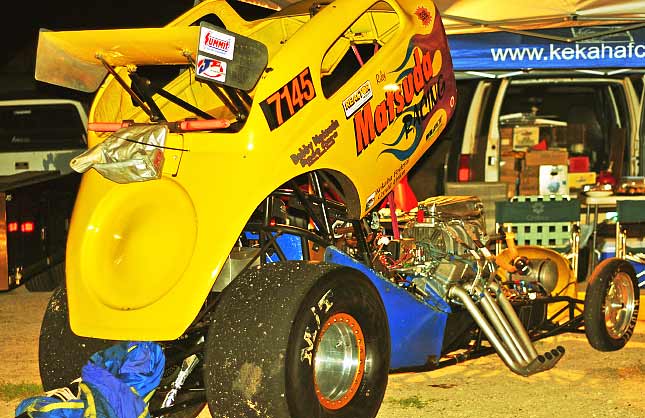 Bobby Matsuda Race Cars built the chassis using 4130 1-5/8 tubing. A Ford 9-inch nodular iron third member with 4.35 gears is filled with a Strange Engineering spool. Mark Williams axles turn the Centerline rear wheels with Mickey Thompson slicks. The floater rear-end features Airheart brakes tucked inside the wheels. A Deist chute completes the stopping package for the Fiat. A Mark Williams drive shaft and Strange couplers feed the horsepower from an owner-built GM powerglide with a Hurst shifter. A TCI transbrake, blanket and a Reactor Flywheel complete the trans package.
Bobby Matsuda Race Cars built the chassis using 4130 1-5/8 tubing. A Ford 9-inch nodular iron third member with 4.35 gears is filled with a Strange Engineering spool. Mark Williams axles turn the Centerline rear wheels with Mickey Thompson slicks. The floater rear-end features Airheart brakes tucked inside the wheels. A Deist chute completes the stopping package for the Fiat. A Mark Williams drive shaft and Strange couplers feed the horsepower from an owner-built GM powerglide with a Hurst shifter. A TCI transbrake, blanket and a Reactor Flywheel complete the trans package.
The powerplant is a small block Chevy, but the engine combination itself is somewhat unusual in its simplicity. You see, George has a shop full of 350-inch Chevys, so fifteen years ago when he built his first supercharger engine, rather than use a lot of expensive aftermarket parts he used as many stock components as he could to build his engines. The heart of the motor -- the cast block and crank -- are stock GM cast units. George does install aftermarket rods and pistons, and a Chet Herbert roller cam. He bolts a set of Pro Comp aluminum cylinder heads built using Crane rocker arms and Manley valves onto the stock iron block. The block is thoroughly cleaned and George admitted to running a “dingleberry” hone down all of the cylinders.
The heads are O-ringed using a tool from Isky to keep from torching the SCS copper head gaskets if possible but other than that are “box stock.” “We don’t run any water so I work hard at sealing up the combustion chamber,” Matsuda said.
“I have a garage full of these small blocks. When we build an engine I don’t bore it or stroke it. I use the block just like they are and the only modification to the crank is that I have Pembrook Industries cut a quarter-inch keyway in the snout.”
He doesn’t even bother to balance the rotating assembly.
The only real issue they seem to have with the motor combination is that eventually one of the small block’s cylinder walls cracks. Since George doesn’t run any water in the block when they see some in the water jackets they know they have one more run.
The most laps one of George’s small blocks has lasted is 48 -- not bad for a stock block and no balancing at all!
The altered weighs a hefty 1580 lbs without driver Riley Takayama between the pipes and has a best ET and speed of 7.78/170.00. George calculates the small block is making about 650 hp.
As do all of the racers in the Hawaiian islands, the Matsuda team have to be as self-sufficient as they can since virtually every part they buy for the car has to be shipped in from the mainland. These racers have to do as much as they can themselves to afford to race.
“We are not rich,” explained George, “so building our own stuff enables us to keep on racing. This approach began when we built our first car, a 1933 Chevy altered.”
“I’ve been racing for 40 years and the key is to have fun yet be able to afford it.” George said. It would appear the Matsuda team of Hilo, Hawaii are doing just that -- drag racing for fun.

